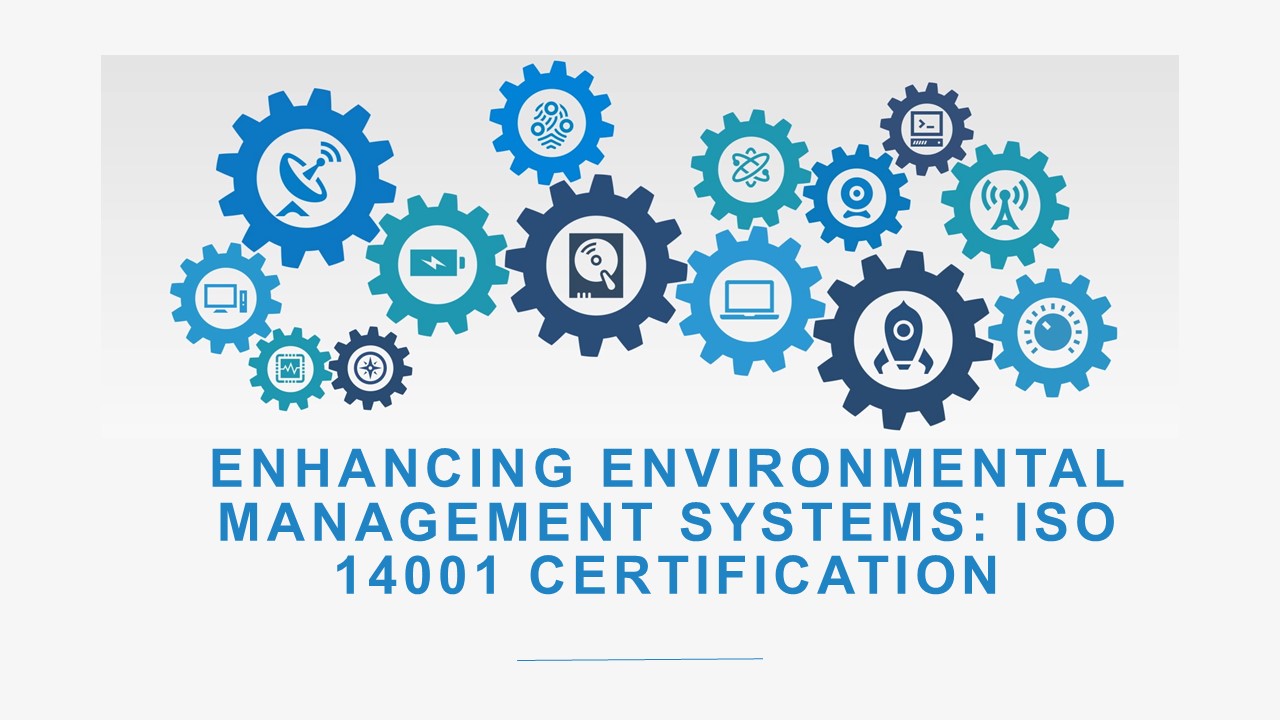Enhancing Environmental Management Systems: ISO 14001 CERTIFICATION - PowerPoint PPT Presentation
Title:
Enhancing Environmental Management Systems: ISO 14001 CERTIFICATION
Description:
ISO 14001 certification is a globally recognized standard for environmental management systems (EMS). It helps organizations establish, implement, and continually improve their environmental performance by setting clear environmental objectives, managing risks, and ensuring compliance with regulations. Certification demonstrates a commitment to sustainability, resource efficiency, and environmental responsibility. – PowerPoint PPT presentation
Number of Views:4
Title: Enhancing Environmental Management Systems: ISO 14001 CERTIFICATION
1
ENHANCING ENVIRONMENTAL MANAGEMENT SYSTEMS ISO
14001 CERTIFICATION
2
TABLE OF CONTENT
- INTRODUCTION
- Importance of Environmental Management
- Key Principles of ISO 14001
- Benefits of ISO 14001 Certification
- OBJECTIVES OF ISO 14001 CERTIFICATION
- Process of iso 14001 certification
- Steps to Achieving ISO 14001 Certification
- Overcoming Challenges in Certification
- ISO 14001 in Action
- Conclusion
3
INTRODUCTION
ISO 14001 certification is an international
standard for Environmental Management Systems
(EMS), providing a framework for organizations to
manage and improve their environmental
performance. It helps businesses minimize their
environmental impact by identifying, controlling,
and reducing the effects of their activities on
the environment. ISO 14001 requires organizations
to set environmental objectives, comply with
regulations, and continuously improve processes.
The standard is applicable to all types and sizes
of organizations, supporting sustainability
efforts, enhancing efficiency, and fostering
compliance with environmental laws. Achieving ISO
14001 certification demonstrates an
organization's commitment to environmental
responsibility and continuous improvement.
4
Importance of Environmental Management
Environmental management is crucial in addressing
sustainability challenges by helping businesses
minimize their environmental footprint. Companies
play a key role in reducing environmental impact
through resource efficiency, waste reduction, and
compliance with environmental regulations. By
adopting sustainable practices, businesses not
only lower operational costs but also enhance
brand reputation, manage risks, and contribute to
global efforts like combating climate change and
preserving ecosystems. Ultimately, environmental
management supports both long-term business
success and the well-being of the planet.
5
KEY PRINCIPLES OF ISO 14001
- Plan-Do-Check-Act (PDCA) Cycle
- Explain how the PDCA model applies to
environmental management. - Continuous Improvement
- How ISO 14001 focuses on enhancing environmental
performance over time. - Compliance and Risk Management
- Importance of meeting legal requirements and
mitigating environmental risks.
6
BENEFITS OF ISO 14001 CERTIFICATION
- Improved Environmental Performance
- Reduced waste, energy consumption, and pollution.
- Cost Savings
- Through efficient resource use and waste
reduction. - Legal Compliance
- Ensuring adherence to environmental laws and
regulations. - Reputation Enhancement
- Demonstrating commitment to sustainability can
attract eco-conscious consumers and partners. - Market Access and Competitive Advantage
- Certification as a differentiator in
environmentally-conscious markets.
7
OBJECTIVES OF ISO 14001 CERTIFICATION
- Enhance Environmental Performance
- Ensure Legal and Regulatory Compliance
- Promote Continuous Improvement
- Reduce Environmental Risks
- Improve Resource Efficiency
- Foster Environmental Awareness
- Enhance Reputation and Stakeholder Trust
- Support Sustainable Business Practices
- Achieve Competitive Advantage
- Reduce Operational Costs
8
STEPS TO ACHIEVING ISO 14001 CERTIFICATION
- 1. Planning Gap Analysis
- Assess current environmental practices vs. ISO
14001 requirements. - 2. Setting Environmental Objectives
- Define measurable goals to improve environmental
performance. - 3. Implementing EMS
- Develop and deploy policies, procedures, and
processes. - 4. Monitoring Measuring Performance
- Track progress against objectives and legal
compliance. - 5. Internal Audits Management Review
- Continuous monitoring and review for
improvements. - 6. Certification Ongoing Maintenance
- Third-party audit and ongoing certification
maintenance.
9
Overcoming Challenges in Certification
- Common Barriers
- High initial investment, resource allocation,
lack of internal expertise. - How to Overcome Them
- Focus on long-term benefits, secure management
commitment, and educate employees.
10
ISO 14001 in Action
ISO 14001 certification empowers organizations
to implement effective Environmental Management
Systems (EMS) that drive continuous environmental
improvements. In action, it helps businesses
streamline their operations to reduce waste,
conserve resources, lower energy consumption, and
ensure regulatory compliance. Companies that
embrace ISO 14001 often see tangible benefits
such as cost savings, improved stakeholder
relationships, and enhanced brand reputation. By
setting clear environmental objectives, measuring
performance, and making data-driven decisions,
businesses can not only minimize their
environmental impact but also create a
sustainable competitive advantage in the market.
NOTE apply for iso 9001 certification - quality
management systems
11
Conclusion
ISO 14001 certification is a powerful tool for
organizations seeking to improve their
environmental performance and sustainability
practices. By establishing a robust Environmental
Management System (EMS), businesses can reduce
their environmental footprint, ensure compliance
with regulations, and achieve long-term cost
savings. Beyond compliance, ISO 14001 fosters
continuous improvement, helping companies enhance
efficiency, reduce waste, and build a strong
reputation as environmentally responsible
leaders. Ultimately, ISO 14001 not only benefits
the environment but also drives business success
through operational excellence and greater
stakeholder trust.
12
https//isoregistrar.org/iso-14001-2015-certificat
e.php
8678846088
care_at_isoregistrar.org
13
THANK YOU































